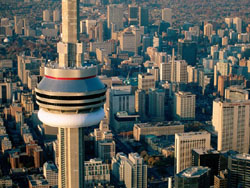Termites - Toronto's $120,000,000 problem
Termite infestations in the Greater Toronto Area cause an estimated $120,000,000 worth of property damage annually. This makes termites the most destructive insect in Southern Ontario; even more destructive than carpenter bees and carpenter ants Read more...
Toronto Termite Inspections
Termite Testing & Removal Services
416-575-6111

Termite Facts:
- Termites' closest insect relatives are cockroaches.
- Termites cause more damage than tornadoes, hail storms,
wind storms, and hurricanes combined.
- Termites cost North Americans more than $1 billion in property damage each year.
- You can buy insurance for many sources of home damage,
but not for termites.
- Termites have been around for more than 240 million years and like their cockroach cousins, can adapt to ever changing environments.
- Termites can not determine the difference between the wood
found in forests and the wood in your home.
- Termites can infest almost every part of your home.
- Termites can enter your home through a crack or opening
as thin as a piece of paper.
- Termites never stop working and eating. They work 24 hours a day.
- Termite colonies can average more than a million termites.
Contact Termiteinspections.ca for a free initial consultation or for more information about termite inspection services in Toronto.

Termites are Wood Destroying Insects (WDI). They feed on cellulose, the basic building block of wood, including lumber used in home construction. Thousands of homes in Toronto are built of wood and if left unprotected or monitored, can fall prey to termite infestation and attack. Extreme cases of termite infestation can lead to homes being condemned. Less extreme cases can result in thousands of dollars of home renovations and property devaluation. If you think you have a termite problem, consider hiring a reputable termite inspection company.
Termites in Toronto
It is believed that Termites first arrived in Southern Ontario via Toronto's harbor in 1938, most likely in shipping cargo. By 1953, they made their way as far north as the Bloor-Danforth Avenue area. Today, instances of termite infestations can be found in a number of well known Toronto neighborhoods.
Collection of termite infestation data in Toronto ended in 1992 when the Provincial Ministry of Environment's Termite Control Program ceased to provide funds to assist homeowners with the cost of chemical treatments. At last count (1993), a total of 543 blocks were known to be infested within the boundaries of the City of Toronto. As of 2001, it was estimated that approximately 650 to 700 blocks in the Greater Toronto Area were infested with termites, and growing.
As a result of the Ministry of Environment's decision to end funding to its Termite Control Program, the onus is now on homeowners to detect, control and manage any instances of residential termite infestation.
Of course, the best method of termite control is to prevent infestations from occurring in the first place.
Termite Inspection Services in Toronto
Termite inspections take place during the months of May through November and should always start in the yard. Any moveable wood in soil contact, such as firewood, lumber, cardboard boxes, barrels, planting boxes, etc., should be examined. Any stumps in the yard should be examined using a pocket-knife to separate the bark from the wood. Also, all of the following areas should be carefully checked for the presence of termites:
- crevices in the bark of large trees,
- compost bins,
- garages including cardboard or wood boxes used for storage,
- crawl spaces under porches and decks,
- and exposed foundation walls.
If you think you may have a termite infestation, Contact Termiteinspections.ca for a free initial consultation or for more information about termite inspection services in Toronto.
Termite Detection & Prevention Tips
- A termite home inspection is recommended annually and before buying or selling a home; especially if you reside in a neighborhood known for having termite problems.
- Reducing wood to ground contact (i.e. wood siding, fencing, porches and decks). It is recommended that there be a minimum of 6 inches clearance between wood siding and the soil.
- Wood decking and porches built on the soil surface or in contact with the soil should be treated.
- Avoid excessive moisture under or adjacent to wood structures. For instance, AC condensate drain lines draining next to wood foundations, or poor surface drainage. Use the advice of a professional in this area due to the possibility of causing foundation and or drainage problems.
- Foliage growing next to and/or near termites should be trimmed back and away from the structure.
- Wood piles adjacent to or near termites should be removed and inspected.
- Wood fence in contact with termite structures should have at least 6 inches of clearance or be treated.
- Wood used in and over foundation expansion joints should be removed and the joints treated.
- Tree branches, stumps, roots and dead trees in contact with termite structures should be cut back and/or removed from the structure.
- Wood form boards left in place around your homes foundation should be removed or treated
Contact Termiteinspections.ca for a free initial consultation or for more information about termite inspection services in Toronto.








